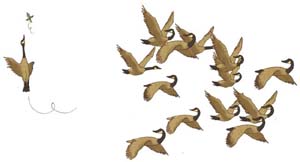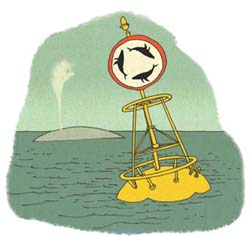 |
 |
| current issue |  |
past issues |  |
send a letter/news |  |
address update |  |
advertise |  |
about us |  |
alumni home |
by Crystal Ward Kent '78
Illustrations by Izhar Cohen
In this issue:
Accepting ImperfectionNewcomers Not Welcome
Right Whale Roundabout
Accepting Imperfection
How people think can't be predicted precisely

|
Commerce makes the world go round, and every day, economists ponder the world's business transactions in an effort to predict what the future will hold. Will the stock markets rise or fall? Are we heading toward a recession? Their predictions are based on models that try to factor in the motivation behind those business transactions. But according to Michael Goldberg, a UNH associate professor of economics, these models are fundamentally flawed.
"How people make business decisions affects economic activity," says Goldberg. Economists, he says, try to factor in this decision-making by using either the so-called rational-expectations theory, which attempts to specify exactly what rational behavior is, or the increasingly popular behavioral economics, which assumes that individuals behave irrationally. Both schools of thought assume that human behavior can be captured by fixed rules that can be run on a computer.
Recording Fitz's choices is the first step in an experiment designed to test the bird's meta-memory--an awareness of its own cognitive skills. The answer might provide one small piece of the puzzle Gibson is trying to solve. "People can tell us what's going on inside their heads," notes Gibson. "Birds can't. We're trying to figure out what's in there by observing what they do."
Goldberg and Roman Frydman, an economics professor at New York University, have developed a new theory they call Imperfect Knowledge Economics, or IKE, that argues human decision-making can never be exactly predicted. "How and when individuals revise their ways of thinking about the past and the future cannot be programmed into a computer," says Goldberg. "Decisions are creative. It's no wonder that contemporary economic models fail miserably to explain outcomes in real-world markets."
But Goldberg and Frydman say human behavior does display certain patterns that economists can build into their mathematical models. IKE "indicates what factors a forecaster might want to take into account, and how these factors, in a human behavioral way, may influence future market outcomes," says Goldberg. Beyond that, an economic forecaster has to be like an entrepreneur, studying history and relying on intuition and judgment.
Goldberg and Frydman have written a book together called Imperfect Knowledge Economics, which has a foreword by Edmund S. Phelps, the 2006 winner of the Nobel Prize in economics.
"Economists need to make some predictions, but we shouldn't try to be too exact about what is going to happen, because we don't know," says Goldberg. Their theory offers a middle ground, he says. "It doesn't pretend to offer exact predictions. It recognizes our own imperfection of knowledge and offers predictions of human behavior that depend on the context."
Newcomers Not Welcome
Argentina's elite used 'science' to keep power
What happens when a government decides to use "science" for its own ends? In late-19th century Argentina, the answer is the "scientifically" justified repression of immigrants, says Julia Rodriguez, a UNH associate professor of history and women's studies.
Rodriguez, who is of Cuban and Jewish-American descent, says at that time only the elite in Argentina could aspire to higher education or be involved in government. But beginning in the 1870s, Argentina started to encourage immigration. The hope was to attract workers from Great Britain, Germany and "the North." Instead, immigrants began arriving from Spain and southern Italy, countries deemed inferior. By 1914, nearly 3 million immigrants had arrived.
The ruling class panicked. The immigrants wanted to participate in society and government. They had plans and ambitions.

|
"Something had to be done," says Rodriguez. "The leaders used the scientific research of the day to 'show' that the immigrants were intellectually, culturally and genetically inferior, and therefore not capable of being viable citizens." Immigrants, they said, carried genetic traits that made them more likely to be alcoholics, to suffer from mental illness, and to carry disease. Some scientists even claimed physiological traits or facial features could indicate criminal tendencies. All of these erstwhile scientific claims were used to control who could gain citizenship and who could not.
Programs were created to fingerprint immigrants, measure the bodies of prisoners as "scientific evidence," put disobedient wives in "houses of deposit," and expel social undesirables, including labor organizers and prostitutes.
Argentina wasn't alone in applying so-called science to political issues. "Biological theories of crime were being pursued in the United States and Europe," she notes. Cesare Lombroso, an Italian surgeon and criminologist who developed forensic science, believed that criminality was inherited and that criminals were a distinct species he called Homo delinquens.
Rodriguez says that many Argentinian scientists truly cared about people and wanted them to live better lives. Much of their research was conducted with that in mind, but the state took control of certain ideas and used them in ways that were exclusionary.
"The lesson to be learned is that at any given time, different scientific ideas are out there," says Rodriguez, whose research formed the basis of a new book, Civilizing Argentina: Science, Medicine and the Modern State. "What is critical is how the state decides which ideas to pursue and for what reasons. Are these ideas that will ultimately exclude people—or expand their quality of life?"
Right Whale Roundabout
Ships and whales at sea make a lethal combination
Igor Tsukrov does not usually have a 500-pound whale jawbone in his lab waiting for analysis. The associate professor of mechanical engineering normally studies how the components of various structural systems, like nanoreinforced polymers and composite materials, react to stress.
But during a collaboration with biologists at Woods Hole Oceanographic Institute and the New England Aquarium, Tsukrov learned of a growing danger to right whales, and he was eager to help.

|
The North Atlantic right whale is one of the rarest of the world's whales. Although protected from commercial hunting since 1935, and declared an endangered species since 1974, the population has continued to decline and only 300 to 350 of these mammals now remain.
Collisions with ships are the top threat to North Atlantic right whales. Many have been killed as they journey back and forth from their breeding grounds off Florida to feeding areas in the Gulf of Maine. This ancestral migration route cuts across some of the Atlantic's busiest shipping lanes, outside of Boston and New York City. In 2006, six North Atlantic right whales were accidentally killed. Although the whale is one of the largest mammals on Earth, weighing up to 70 tons and measuring up to 50 feet in length, it's no match for a 300,000-ton cargo ship underway at 25 knots.
Right whales are notoriously slow moving, occasionally diving for food and then basking on the surface. By the time a ship sights them, it often cannot stop, and the whale is not fast enough to escape.
"The whales have been following these migration routes for thousands of years," says Tsukrov. "They will not deviate from this path. They see the ships and are not scared. Scientists have tried a variety of underwater sounds to drive the whales away, but not only did this not work, in some cases, it actually attracted the whales." The solution, scientists believe, is to shift the shipping lanes and get the ships to slow down.
The shipping industry has resisted changes to ship speed or travel routes, claiming that there has been insufficient data to prove that ship collisions are fatal. The industry also estimates that changing speeds by even a few knots or altering routes could cost $50-$150 million per year.
With NOAA funding, Tsukrov and colleagues Ken Baldwin '77G, professor of ocean engineering, and Judson DeCew '99, '02G, research engineer in ocean engineering, were able to perform studies detailing the precise biomechanics of what happens when a ship strikes a North Atlantic right whale.
"Whale bones are unlike any other mammal bones," says Tsukrov. "Whales float in a zero-gravity state and don't need bone rigidity to support them. In our studies, we looked at how these bones reacted under stress, their resistance to load, and at what point a break would occur."
The UNH team worked with Woods Hole biologists to gather whale bone data with regard to collision impacts. As a result of the collaboration, the body of knowledge went from "zero to significant," he says.
As a result of the extensive work by right whale researchers, including the UNH team, NOAA proposed changes last year in the Boston Harbor Traffic Separation Scheme, shifting and narrowing the lanes during whale migrations. The International Maritime Office, representing the interests of the international shipping industry, endorsed the proposal in late 2006. NOAA calculates the realignment could provide a 58 percent reduction in ship-strike risk to migrating North Atlantic right whales.
Perhaps with this agreement, and a lot of luck, the whales' collision course with extinction can be averted.
blog comments powered by Disqus

